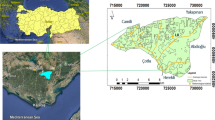Abstract
Evapotranspiration is a key parameter in agricultural water planning and management strategies because it determines the crop and irrigation water requirements. With the recent advance in satellite-based field observations and meteorological modeling, several techniques have been developed and applied to estimate actual evapotranspiration. This paper presents the first results of the application to field evapotranspiration monitoring of land surface temperatures observed by Japan’s new Global Change Observation Mission-Climate (GCOM-C) satellite. Through a test application conducted in an irrigation region in the western USA, specifications of the GCOM-C surface temperature observation and the derived field evapotranspiration were evaluated. The specifications of the surface temperature observation were that the satellite observed the study fields with a spatial resolution of about 300 m at a frequency of 4–5 days per week. Clouds further degraded observation frequency. However, at least one constant successful observation of land surface temperature was available each week during the study period from June 17 to July 21, 2018. With the unique spatial and temporal resolution of GCOM-C, the surface temperature data allowed weekly monitoring of individual field evapotranspiration for large-size fields. Estimation results of field evapotranspiration by the GCOM-C ETindex estimation algorithm were evaluated for fields of wheat, pea, alfalfa, bean, and corn/potato/beet, as well as for rangeland. The result reasonably explained the relative differences of evapotranspiration among the different crop types and among individual fields having the same crop type. Quantitatively, some indications of underestimation of evapotranspiration were found during the application.








Similar content being viewed by others
References
Allen RG, Pereira LS, Raes D, Smith M (1998) Crop evapotranspiration—guidelines for computing crop water requirements. FAO Irrigation and Drainage Paper 56, FAO, Rome, Italy
Allen RG, Tasumi M, Morse A, Trezza R, Wright JL, Bastiaanssen W, Kramber W, Lorite IJ, Robison CW (2007a) Satellite-based energy balance for mapping evapotranspiration with internalized calibration (METRIC)—applications. J Irrig Drain Eng 133:395–406
Allen RG, Tasumi M, Trezza R (2007b) Satellite-based energy balance for mapping evapotranspiration with internalized calibration (METRIC)—model. J Irrig Drain Eng 133:380–394
Biggs TW, Petropoulos GP, Velpuri MN, Marshall M, Glenn EP, Nagler P, Messina A (2016) Remote sensing of actual evapotranspiration from croplands. In: Thenkabail PS (ed) Remote sensing of water resources, disasters, and urban studies, volume III of remote sensing handbook. CRC Press, Boca Raton
Black M (2016) The atlas of water, 3rd edn. University of California Press, Berkeley
Bos MG, Kselik RAL, Allen RG, Molden D (2009) Water requirements for irrigation and the environment. Springer, Berlin
Denih A, Maeda A, Tasumi M, Shinohara Y, Takeshita S (2018) Evaluation of GCOM-C ETindex Estimation Algorithm at a Lodgepole Pine Tree Open Forest in Idaho, USA. J Rainwater Catchment Syst 24:9–14
Doorenbos J, Pruitt WO (1977) Crop water requirements. FAO Irrigation and Drainage Paper No. 24, FAO, Rome, Italy
Fujii A, Tasumi M (2013) Testing the performance of a thermal-based crop coefficient technique in Idaho as a fundamental study for global ET estimation. J Agric Meteorol 69:127–134
Sobrino JA, Frate FD, Drusch M, Jiménez-Muñoz JC, Manunta P, Regan A (2016) Review of thermal infrared applications and requirements for future high-resolution sensors. IEEE Trans Geosci Remote Sens 54:2963–2972
Surendran U, Sushanth CM, Mammen G, Joseph EJ (2015) Modelling the crop water requirement using FAO-CROPWAT and assessment of water resources for sustainable water resource management: a case study in Palakkad district of humid tropical Kerala, India. Aquat Procedia 4:1211–1219
Tasumi M (2016) Spatial estimation of evapotranspiration using satellite imagery from regional to global scales. In: Proceedings of international conference on dry zone agriculture 2016, Jaffna, Sri Lanka, vol 2, pp 14–18
Tasumi M (2017) Technical Report for the 2016 JAXA Collaborative Research—development of global evapotranspiration index estimation algorithm as a GCOM-C land product. JX-PSPC-434805, University of Miyazaki submitted to JAXA, Japan (in Japanese)
Tasumi M, Allen RG (2007) Satellite-based ET mapping to assess variation in ET with timing of crop development. Agric Water Manag 88:54–62
Tasumi M, Kimura R (2013) Estimation of volumetric soil water content over the Liudaogou river basin of the Loess Plateau using the SWEST method with spatial and temporal variability. Agric Water Manag 118:22–28
Tasumi M, Allen RG, Trezza R, Wright JL (2005) Satellite-based energy balance to assess within-population variance of crop coefficient curves. J Irrig Drain Eng 131:94–109
Tasumi M, Kimura R, Moriyama M, Allen RG, Fujii A (2012) Estimation of global ET-Index from satellite imagery for water resources management. In: Proceedings of SPIE—land surface remote sensing, Kyoto, Japan. https://doi.org/10.1117/12.976283
Tasumi M, Kimura R, Allen RG, Moriyama M, Trezza R (2016a) Development of the GCOM-C global ETindex estimation algorithm. J Agric Meteorol 72:85–94
Tasumi M, Moriyama M, Hirakawa K, Fujii A (2016b) Evaluation of the GCOM-C global ETindex estimation algorithm. J Agric Meteorol 72:151–158
Zhou T, Wu P, Sun S, Li X, Wang Y, Luan X (2017) Impact of future climate change on regional crop water requirement—a case study of Hetao Irrigation District, China. Water 9:429. https://doi.org/10.3390/w9060429
Acknowledgements
This study was supported by a research grant for the Global Change Observation Mission of the Japan Aerospace Exploration Agency (JAXA).
Author information
Authors and Affiliations
Corresponding author
Rights and permissions
About this article
Cite this article
Tasumi, M., Moriyama, M. & Shinohara, Y. Application of GCOM-C SGLI for agricultural water management via field evapotranspiration. Paddy Water Environ 17, 75–82 (2019). https://doi.org/10.1007/s10333-019-00699-1
Received:
Revised:
Accepted:
Published:
Issue Date:
DOI: https://doi.org/10.1007/s10333-019-00699-1




